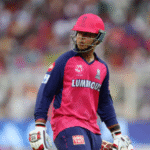The International Cricket Council (ICC) has recently announced significant alterations to the playing conditions for One Day International (ODI) cricket, set to come into effect from July 2, 2025. These changes, particularly a key modification to the two-ball rule, are aimed at restoring a better balance between bat and ball, a factor that many believe has heavily favored batsmen in recent years.
The Revised Two-Ball Rule: A Boost for Bowlers
One of the most impactful changes is the tweak to the two-new-ball rule in ODIs. Previously, two brand new balls were used, one from each end, for the entirety of an innings. This often meant that balls remained hard and new, making it difficult for bowlers, especially spinners, to extract reverse swing or grip in the latter stages of the innings.
Under the new regulation, while two new balls will still be used from overs 1 to 34, a crucial change occurs from the 35th over onwards. At this point, the fielding team will choose one of the two balls to continue bowling with for the remainder of the innings (overs 35-50). This strategic shift is designed to allow the chosen ball to get older and softer, thereby reintroducing the possibility of reverse swing and making it more challenging for batsmen in the death overs. In matches reduced to 25 overs or less before the first innings, only one new ball will be used.
Stricter Concussion Substitution Protocols
In a move to enhance player safety and ensure greater transparency, the ICC has also tightened the regulations surrounding concussion substitutes. Teams will now be required to pre-name five designated concussion replacements to the match referee before the toss. This list must be role-specific, including one wicketkeeper, one batter, one seam bowler, one spinner, and one all-rounder. This aims to prevent any tactical misuse of the rule and ensures like-for-like replacements are more clearly defined. In rare circumstances where a substitute also suffers a concussion, the match referee will have the discretion to approve a replacement from outside the initial five, adhering to existing like-for-like protocols.
Addressing the Bat-Ball Balance
For a considerable period, many cricketers and pundits, including former India spinner Ravichandran Ashwin, have voiced concerns about the diminishing contest between bat and ball in ODIs. The prevalence of flat pitches, shorter boundaries, and the previous two-new-ball rule were seen as factors contributing to heavily skewed scores and predictable outcomes. The reintroduction of reverse swing through the modified ball rule is a direct response to these concerns, aiming to bring back a key skill for fast bowlers and give spinners more purchase on older balls.
Implementation Timeline and Broader Context
These new playing conditions are part of the ICC’s ongoing efforts to evolve the game and maintain its competitive integrity. The changes for ODIs will be implemented from July 2, 2025, while Test matches will see new rules from June 17, 2025, and T20Is from July 10, 2025.
The ICC recognizes the need to keep ODI cricket engaging for both players and fans, especially with the growing prominence of T20 leagues. These rule modifications are seen as a vital step in ensuring the format remains relevant and provides a more even playing field for both sides. The impact of these changes will be closely watched as teams prepare for the 2027 Cricket World Cup in South Africa, Zimbabwe, and Namibia.


